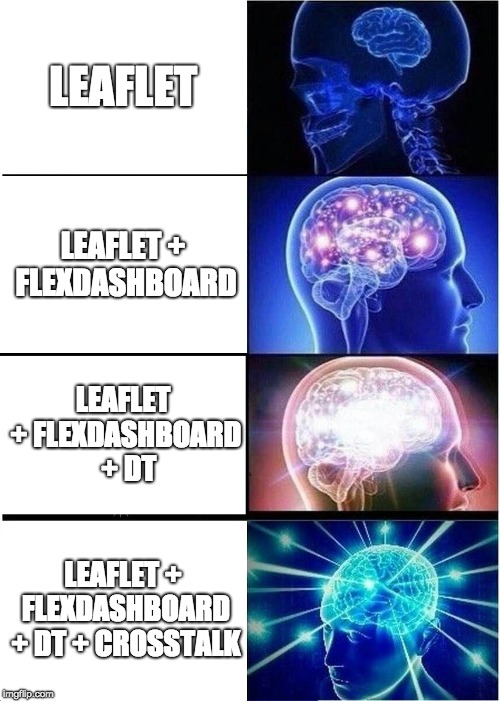- See the full demo of
crosstalkwithleafletandDTin aflexdashboard(see the 'Stages of development' section below for the intermediate demos) - See my EARL 2018 presentation for which these the demos were used or access its source code
- Read a blog post about the presentation
- I did an 'advent of memes' on Twitter leading up to the talk; I know that's why you're really here
This repo contains code for some materials I used in a presentation at the EARL (Enterprise Applications of the R Language) conference in London on 12 September 2018.
The presentation was about use of Joe Cheng's crosstalk package to help solve a business problem. crosstalk lets you create Shiny-like 'apps' without Shiny. You might want to do this because you don't have a server to host a Shiny app. It lets filtering of one crosstalk-compatible htmlwidget (e.g. leaflet, DT and plotly) filter other crosstalk-compatible htmlwidgets.
I gave this talk while I worked for the Department for Education, part of the UK government. My talk was restricted to published data only and the content of the talk does not reflect or constitute official government policy. Schools were selected at random from open data.
Crosstalk: Shiny-like without Shiny
Self-service interactive tools have great power to support decisions by policy-makers. Shiny apps are a natural fit for this, but it's not always easy to share them within the public sector. This is due to issues like a lack of server space, highly sensitive data and users who aren't R-savvy.
We've approached this problem in the UK's Department for Education by sharing interactive HTML widgets – embeddable JavaScript visualisation libraries – within RMarkdown outputs. Interactivity is, however, limited because selections in one widget don’t impact the data presented in another.
Joe Cheng's Crosstalk package (http://rstudio.github.io/crosstalk/) overcomes this with shared data objects that react to user inputs, altering the content of multiple widgets on the fly. I'll explain how I used Crosstalk to develop a 'pseudo-app' for exploring schools data with the Leaflet (maps), Plotly (charts) and DT (tables) widgets inside the Flexdashboard framework and how I shared it easily with policy-making users as a static HTML file for exploration in the browser.
The talk demonstrated a four-step process in the development of an interactive map tool given user feedback at each stage. Example code is hosted in this repo and the HTML outputs are viewable in-browser. The steps are shown below (click to be taken to the example):
- Leaflet
- Leaflet + Flexdashboard
- Leaflet + Flexdashboard + DT
- Leaflet + Flexdashboard + DT + Crosstalk
And in meme format if you prefer:

